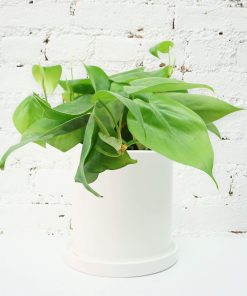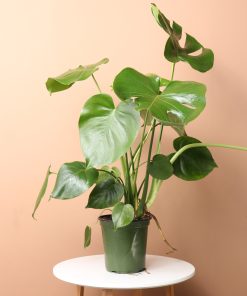Our greenhouse is proud to house the Philodendron hederaceum, a flowering beauty that belongs to the Araceae family. Our medium size Hederaceum grows to about eight inches tall and half a foot wide, give or take, however, all plants will differ slightly when fully grown. This beauty is native to Central America as well as the Caribbean, so it loves humid environments of at least 60 Fahrenheit degrees or higher. Our customers love the Philodendrons twisting vines that can either work as a hanging plant or be manipulated to crawl upwards on any wall. Other names for the Hederaceum include Heart-Leaf Philodendron.
Hederaceum Benefits
When considering a Philodendron hederaceum purchase, you may be wondering if it has any particular benefits. Even if you weren’t, we’re gonna tell you anyway. One of the greatest things about this beauty is its air purifying ability. More specifically, it removes chemicals like formaldehyde from the area around it. Other benefits of this plant include its versatility. The Hederaceum can also adjust to tolerate a range of lighting and water conditions due to its darker leaves which allow it to absorb maximum resources.
Tree Lover
The word Philodendron is Greek, with the first part ‘philo’ meaning ‘love’, and the last part ‘dendron’ meaning ‘tree’, or ‘tree lover’ all together. This was probably decided because of how much this plant loves to climb up trees by creeping its vines slowly around their trunks when in its natural jungle habitat
Mistaken Identity
Sometimes this plant is miscategorized as the Philodendron scandens, Philodendron oxycardium, or the Pothos hederaceus, because of how similar the vines and leaves appear. When making the distinction however, the Philodendron hederaceum differences are in its leaf texture and shape. The Hederaceum has thinner leaves with a smooth, almost matte looking texture, while Pothos leaves are thicker, glossy, and bumpier.
Spread the Love
Commonly, the Philodendron hederaceum can grow fast and out of control. If you see your plant reaching unmanageable sizes, you can always propagate it. The process is easy, just take a pair of scissors and cut the part you want by the stem. Make sure to include at least one node so it can sprout leaves. A node is like a blemish in the plant where the leaf has detached. It’s small and round and looks like a little bud. Once you’ve done that, you can place your detached baby in a glass container with clean water. After a few days of sitting in the son, roos should star to appear. Once this has happened, you can re-pot in soil.
Now that you’re an expert with the Philodendron Hederaceum, order this plant by 7PM est to get this plant shipped out of our greenhouse in New Jersey tomorrow (if you are wondering the arrival time, check with the zipcode validator on top of the Add To Cart). Seriously, our plant shipping solution is truly protective and innovative to ensure your plants arrive safe and intact! In case you were still wondering, we WILL send out the EXACT plant that you picked out, just like that of a local nursery or garden center, except we have more and fresher plants to choose from and you can’t find our PAFE fine ceramic planter options anywhere else other than our website 🙂
For any other questions or concerns, please don’t hesitate to reach out to us

































